5C - design project
/
Back at the beginning of May there was a post on the site about the new buses that have been put onto the 5C route through the city. But the buses are simply the most obvious part of a complicated and carefully co-ordinated design project.
New bus stops have been built along the route and the longer buses meant that bus bays had to be extended at some stops so the work was co-ordinated with the city roads planners.
There is a clear colour scheme for the buses with a strong blue and rich yellow and this continues across textiles and graphics but this was not simply a matter of creating a new “house style” because it had to be seen as a step on from existing designs … not too close so it was boring or barely worth the obvious investment but not too much of a difference to require a steep learning curve. Staggering back from work or carrying loads of shopping and pushing a kids buggy you don’t need to be confronted by something so unfamiliar that you are not sure where to go or what to do.
There are far more doors to get on and off the buses so whereas before the entrance was generally at the front past the driver, the new buses can be entered at any of the five doors so there had to be new graphics to explain this and now the doors do not open automatically but with the press of a button … both on the inside but also on the outside. The machines for clocking in and out, some with options for adding extra passengers to your ticket, that have until now been found only on railway and metro platforms are now used actually in the buses.
There are novel features that reflect the much larger number of people on each bus so vertical poles at some points actually split into three - so more people can hold on - and at the articulated join of the two parts of the bus there are barriers to stop you falling against the concertina of the link but this bar is padded so you can use it as a bum rest if you are standing on the join between the two sections.
There are also much-improved graphics for passenger information at a high level so that it can be seen over people standing. As the bus follows a long route - with a lot of stops that cross other bus routes and rail stations - the graphics on a long panel at the centre mark the progress of the bus and the options to change to other routes at each stop.
It would be interesting to know just how many designers were involved on the full project and what the timetable was to interact with quite so many different contractors. This is an extremely good example of just how important good design is even if, for many, it exists very much in the background of their lives.

















